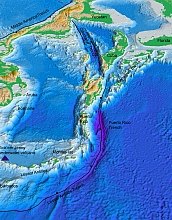|

Press Release 07-056
Real-Time Seismic Monitor Installed on Growing Underwater Volcano

First use for underwater radio telemetry
May 10, 2007
Kick'em Jenny is its name, and for oceanographers working in the southeastern Caribbean Sea, this undersea volcano has been a handful.
Now, a team of marine scientists funded by the National Science Foundation (NSF) and affiliated with the Woods Hole Oceanographic Institution (WHOI) may have figured out how to tame it. This week, the researchers will begin using radio telemetry to monitor the rumblings of Kick'em Jenny from a real-time seismic monitoring device installed on the volcano.
The new technology will improve the ability of natural hazards managers to protect residents from volcanic eruptions and tsunamis, said Alex Isern, program director in NSF's Division of Ocean Sciences. "Basic oceanographic research leads to technological advances that directly benefit society--like detecting hazards--in time to make a difference," said Isern.
Located just off the north coast of the island nation of Grenada, Kick 'em Jenny is a "natural laboratory"--a submarine volcano that will eventually emerge from beneath the sea to form a new volcanic island. It is the only "live" submarine volcano in the West Indies, and has erupted at least 12 times since 1939. The last major eruption occurred in 2001.
Part of a project to develop new technology for earthquake monitoring in coastal areas, the seismic station, called a Real Time Offshore Seismic Station (RTOSS), uses an ocean-bottom seismometer deployed directly on the volcano. RTOSS allows seismic data to be transmitted by high-frequency radio to a land-based observatory in a nearby village. The data will reach the shore within milliseconds of being collected.
"This is the first time that radio telemetry has been used to transmit data from an underwater seismic monitoring station," said Rob Reves-Sohn, a WHOI geologist and RTOSS project leader.
Scientists will be able to observe the "inhaling and exhaling" of the volcano as it draws in and expels seawater, magma and superheated fluids.
The research team is coordinating its efforts with the National Disaster Management Agency in Grenada and the Seismic Unit of the University of the West Indies. The data will be incorporated into the regional monitoring network in the Lesser Antilles.
Funding for the project is also being provided by WHOI and the U.S. Geological Survey.
-NSF-

Media Contacts
Cheryl Dybas, NSF (703) 292-7734 cdybas@nsf.gov
Stephanie Murphy, WHOI (508) 289-3340 samurphy@whoi.edu

The National Science Foundation (NSF) is an independent federal agency that supports fundamental research and education across all fields of science and engineering. In fiscal year (FY) 2009, its budget is $9.5 billion, which includes $3.0 billion provided through the American Recovery and Reinvestment Act. NSF funds reach all 50 states through grants to over 1,900 universities and institutions. Each year, NSF receives about 44,400 competitive requests for funding, and makes over 11,500 new funding awards. NSF also awards over $400 million in professional and service contracts yearly.
 Get News Updates by Email Get News Updates by Email
Useful NSF Web Sites:
NSF Home Page: http://www.nsf.gov
NSF News: http://www.nsf.gov/news/
For the News Media: http://www.nsf.gov/news/newsroom.jsp
Science and Engineering Statistics: http://www.nsf.gov/statistics/
Awards Searches: http://www.nsf.gov/awardsearch/
| 



